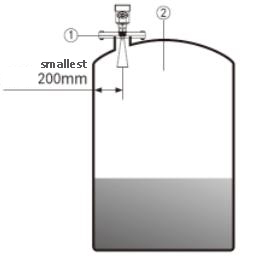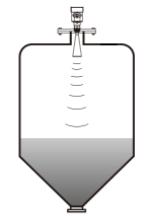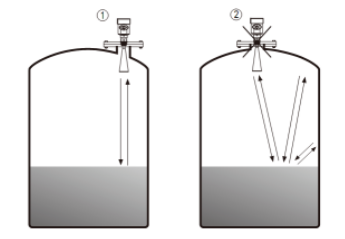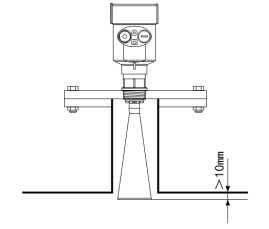Advantages in the use of radar

1. Continuous and accurate measurement: Because the radar level gauge is not in contact with the measured medium, and it is very little affected by temperature, pressure, gas, etc.
2. Convenient maintenance and simple operation: The radar level gauge has fault alarm and self-diagnosis functions.
3. Wide application range: non-contact measurement, good directivity, low transmission loss, and more measurable media.
4. Simple installation: In various industry applications, the radar level gauge can be directly installed on the top of the storage tank. The advantages of simple installation and other advantages have become the first choice for the general public. Next, let’s talk about the problems often encountered in the process of use.
Installation attention to specifications
The radar level gauge measures the liquid level of the tank at 1/4 or 1/6 of the diameter of the tank, and the minimum distance from the pipe wall is 200mm.
Note: ①Datum plane ②Container center or axis of symmetry

The measuring cone-shaped tank should be installed in the middle of the plane of the cone-shaped tank to ensure that the top of the cone can be measured

When measuring tanks with piles of material, when selecting the type, you should choose a universal flange (adjustable direction) to install the radar level gauge. Due to the inclined fixed surface, the echo will be attenuated and even the signal will be lost. So when we install it, we adjust the radar antenna to align it vertically with the material surface.

Summary of typical installation errors
Next, I will share with you some typical wrong installation methods that we often encounter, so that everyone is more comfortable in debugging and installing the radar.
1. Close to the feed inlet
I often encounter friends who are new to the radar. During the installation process, the installation position of the radar is too close to the feed inlet, resulting in inaccurate liquid level measurement during use. Because it is close to the feed inlet, the feed will greatly interfere with the propagation and reflection of the radar medium, so when we install it, we must try to stay away from the feed inlet (the following installation 1 is correct, 2 is wrong)

2. The round tank is installed in the middle
The radar level gauge is a non-contact level gauge. Due to the beam angle, it should be installed as far away as possible from the pipe wall. However, it cannot be installed in a circular or arched tank (as shown in the figure below). Installed in the middle of the top of the tank, in addition to indirect echoes during normal measurement, it will also be affected by multiple echoes. Multiple echoes may be larger than the signal threshold of true echoes, because multiple echoes can be concentrated through the top. Therefore, it cannot be installed in a central location.

3. Radar insertion depth is not enough
The third situation I believe you have encountered more, we need to weld the short circuit during installation, but we often do not pay attention to the length of the short circuit. We think it is only for fixing, so we can weld it casually. All is well, the radar level gauge probe is still short-circuited inside, which leads to inaccurate liquid level measurement. The displayed liquid level is much larger than the actual value and does not change with the height of the liquid level. Therefore, we must pay attention at this time. After the radar level gauge is installed, the probe must extend into the tank with a distance of at least 10mm to ensure the normal operation of the radar level gauge.

Post time: Dec-15-2021




